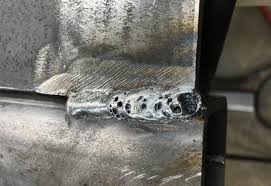What is Porosity in Welding: Typical Resources and Effective Treatments
What is Porosity in Welding: Typical Resources and Effective Treatments
Blog Article
Porosity in Welding: Identifying Common Issues and Implementing Ideal Practices for Prevention
Porosity in welding is a pervasive problem that commonly goes undetected till it triggers significant problems with the integrity of welds. In this conversation, we will certainly discover the key elements contributing to porosity development, analyze its detrimental effects on weld performance, and talk about the best methods that can be embraced to reduce porosity event in welding processes.
Common Reasons of Porosity

Making use of dirty or damp filler materials can present impurities right into the weld, adding to porosity problems. To reduce these common causes of porosity, thorough cleansing of base metals, proper protecting gas option, and adherence to optimum welding criteria are vital practices in attaining top notch, porosity-free welds.
Influence of Porosity on Weld Quality

The presence of porosity in welding can significantly jeopardize the architectural honesty and mechanical properties of bonded joints. Porosity develops voids within the weld steel, deteriorating its overall strength and load-bearing ability.
Among the main effects of porosity is a reduction in the weld's ductility and sturdiness. Welds with high porosity degrees often tend to show reduced impact toughness and decreased capacity to deform plastically prior to fracturing. This can be specifically concerning in applications where the bonded components are subjected to vibrant or cyclic loading problems. In addition, porosity can restrain the weld's capability to efficiently transmit forces, leading to early weld failing and possible safety and security dangers in important frameworks.
Best Practices for Porosity Prevention
To enhance the architectural honesty and quality of welded joints, what details measures can be implemented to decrease the incident of index porosity throughout the welding procedure? Using the proper welding strategy for the specific product being welded, such as readjusting the welding angle and gun position, can additionally avoid porosity. Regular evaluation of welds and immediate remediation of any kind of concerns identified during the welding procedure are vital methods to avoid porosity and generate high-grade welds.
Relevance of Correct Welding Techniques
Carrying out correct welding methods is vital in ensuring the architectural honesty and quality of welded joints, constructing upon the structure of effective porosity avoidance actions. Welding strategies straight affect the overall strength and resilience of the bonded framework. One essential element of correct welding strategies is maintaining the appropriate warmth input. Excessive heat can lead to raised porosity because of the entrapment of gases in the weld pool. Conversely, not enough warmth might lead to insufficient fusion, developing possible weak points in the joint. Furthermore, using the appropriate welding specifications, such as voltage, current, and travel speed, is critical for attaining audio welds with minimal porosity.
In addition, the selection of welding process, whether it be MIG, TIG, or stick welding, need to line up with the details needs of the project to ensure ideal results. Proper cleaning and prep work of the base metal, along with picking the best filler material, are likewise important elements of competent welding techniques. By sticking to these ideal practices, welders can minimize the threat of porosity development and produce top quality, structurally sound welds.

Examining and Quality Control Procedures
Quality assurance procedures play a crucial duty in verifying the stability and reliability of welded joints. Evaluating procedures are crucial to spot and avoid porosity in welding, guaranteeing the toughness and longevity of the last product. Non-destructive screening methods such as ultrasonic testing, radiographic screening, and aesthetic assessment are generally used to identify potential defects like porosity. These strategies permit for the assessment of weld quality without compromising the stability of the joint. What is Porosity.
Post-weld evaluations, on read this article the other hand, assess the final weld for any kind of flaws, consisting of porosity, and validate that it meets defined standards. Carrying out a detailed top quality control strategy that includes thorough testing treatments and assessments is paramount to decreasing porosity issues and guaranteeing the general quality of welded joints.
Conclusion
Finally, porosity in Visit Website welding can be a common problem that influences the top quality of welds. By determining the common causes of porosity and carrying out ideal methods for prevention, such as proper welding strategies and testing actions, welders can guarantee top quality and dependable welds. It is important to prioritize avoidance approaches to lessen the incident of porosity and maintain the stability of bonded frameworks.
Report this page